 W
WAmblygaster sirm, the spotted sardinella, also known as the northern pilchard, spotted pilchard, spotted sardine, and trenched sardine, is a reef-associated marine species of sardinellas in the herring family Clupeidae. It is one of the three species of genus Amblygaster. It is found in the marine waters along Indo-West Pacific regions from Mozambique to the Philippines, and towards north Taiwan and Japan to the far east of Australia and Fiji. It is a widely captured commercial fish in Sri Lanka, where the fish is known as "Hurulla" in Sinhala language.
 W
WThe ocellated angelshark is an angelshark of the family Squatinidae found only from the Taiwan Straits in the western Pacific between latitudes 28 and 22°N and in northern Malaysia. Its length is up to 63 cm.
 W
WThe Taiwan angelshark is an angelshark in the family Squatinidae. The Taiwan angelshark is one of four species of Squatina in the waters around Taiwan and Japan. It is a demersal, ray-like shark that grows to 1–2 meters in length.
 W
WBathygadus antrodes is a gadiform fish, a species of rattail. It is found at depths of up to 1200 m in the waters around southern Japan and northern Taiwan.
 W
WThe Blackedge cusk is a fish species in the family Ophidiidae. It is widespread in the Pacific Ocean from Taiwan and the Arafura Sea to Hawaii, and is a marine subtropical demersal fish, up to 15.5 centimetres (6.1 in) long.
 W
WCandidia is a genus of small cyprinid freshwater fish endemic to Taiwan.
 W
WThe Taiwan saddled carpetshark is a carpetshark of the family Parascylliidae found around Taiwan, between latitudes 28°N and 21°N, at depths to 110 m. Its length is up to 39 cm.
 W
WThe gecko catshark is a species of catshark, part of the family Scyliorhinidae, native to the northwestern Pacific Ocean from southern Japan to Taiwan, and possibly also off Vietnam. It is a common, demersal species found at depths of 100–900 m (330–2,950 ft). Its body is slender, with a pattern of dark saddles and blotches. The dorsal and caudal fins are edged in white, and there is a prominent crest of enlarged dermal denticles along the dorsal edge of the caudal fin. The gecko catshark is a schooling, opportunistic predator of bony fishes, cephalopods, and crustaceans. It is oviparous, with females producing two vase-shaped egg capsules at a time. This species is captured as bycatch, but does not appear to be threatened by fishery activities at present and has been assessed as Least Concern by the International Union for Conservation of Nature (IUCN).
 W
WThe blacktip sawtail catshark is a species of catshark, and part of the family Scyliorhinidae, found off the coasts of Taiwan and the Philippines. It is demersal in nature and occurs deeper than 60 m (200 ft). Growing up to 46 cm (18 in) long, this slim-bodied species is characterized by its plain brownish dorsal coloration with dark tips on the dorsal and caudal fins, and a prominent crest of enlarged dermal denticles on the upper edge of the caudal fin. It is oviparous, with females producing encapsulated eggs two at a time year-round. The blacktip sawtail catshark is caught incidentally in bottom trawls and used for fishmeal in Taiwan. However, the International Union for Conservation of Nature (IUCN) currently lacks enough information to assess its conservation status.
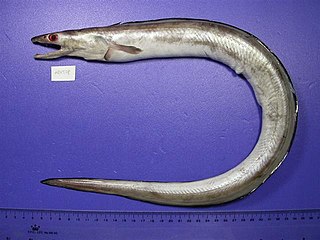 W
WThe dagger-tooth pike conger is a species of eel. They primarily live on soft bottoms in marine and brackish waters down to a depth of 800 m (2,600 ft), but may enter freshwater. They are common to about 1.5 m (4.9 ft) in length, but may grow as long as 2.2 m (7.2 ft). Dagger-tooth pike congers occur in the Red Sea, on the coast of the northern Indian Ocean, and in the West Pacific from Indochina to Japan. It has also invaded the Mediterranean through the Suez Canal.
 W
WEnneapterygius etheostomus is a species of triplefin blenny in the genus Enneapterygius. It is a temperate blenny known to inhabit rocky shores in the northwestern Pacific Ocean, and swims at a depth range of 0–21 metres It has been described from Japan, China, Korea, Hong Kong, Taiwan, and Vietnam. Male E. etheostomus can reach a maximum length of 5.5 centimetres (2.1in) Both juveniles and adults of the species are known to feed on benthic algae.
 W
WGadomus colletti is a species of rattail. This deep-water fish is found in the waters around Japan, the Philippines, and northern Taiwan.
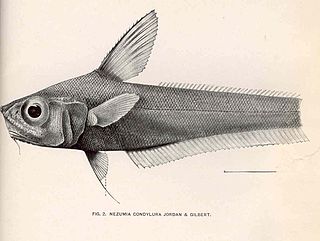 W
WThe Japanese pugnose grenadier is a species of rattail fish. It is found at depths of up to 720 m in the waters around southern Japan, northern Taiwan and in the East China Sea.
 W
WThe brown guitarfish is a species of fish in the Rhinobatidae family. It is found in western Pacific of Taiwan and the Philippines. Its natural habitats are open seas, shallow seas, coral reefs, and estuarine waters. The Taiwan guitarfish was formerly considered a distinct species, but is now considered a junior synonym.
 W
WThe shuttles hoppfish or shuttles mudskipper is a species of mudskippers native to fresh, marine and brackish waters of the northwestern Pacific Ocean from Vietnam to Korea and Japan. This species occurs in muddy estuaries, tidal flats and swamps and marshes and is capable of remaining out of the water for up to 60 hours so long as it is kept moist. This species can reach a length of 10 centimetres (3.9 in) TL. This species can also be found in the aquarium trade and is also used in traditional Chinese medicine.
 W
WThe banded houndshark is a species of houndshark in the family Triakidae, common in the northwestern Pacific Ocean from the southern Russian Far East to Taiwan. Found on or near the bottom, it favors shallow coastal habitats with sandy or vegetated bottoms, and also enters brackish water. This shark reaches 1.5 m (4.9 ft) in length. It has a short, rounded snout and mostly narrow fins; the pectoral fins are broad and triangular, and the trailing margin of the first dorsal fin is almost vertical. It is gray above and lighter below; younger sharks have darker saddles and dots, which fade with age.
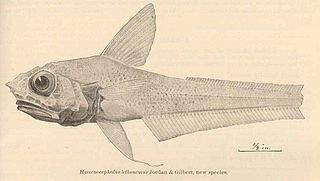 W
WHymenocephalus lethonemus is a species of rattail. It occurs at depths of up to 485 m (1591 ft) in the waters off southern Japan, the Philippines and northern Taiwan.
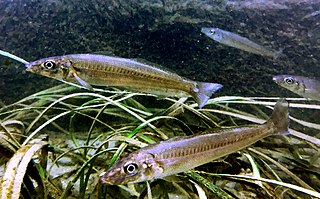 W
WThe Japanese whiting, Sillago japonica, is a common species of coastal marine fish belonging to the smelt-whiting family, Sillaginidae. As suggested by its name, the Japanese whiting was first recorded from Japan in 1843, but has subsequently been found to extend to Korea, China and Taiwan.
 W
WThe bluespotted stingray, also known as the bluespotted maskray or Kuhl's stingray, is a species of stingray of the family Dasyatidae. It was recently changed from Dasyatis kuhlii in 2008 after morphological and molecular analyses show that it is part of a distinct genus, Neotrygon. The body is rhomboidal and colored green with blue spots. Maximum disk width is estimated 46.5 centimeters (18.3 in). It is popular in aquaria but usually not distinguished from the bluespotted ribbontail ray. The ribbontail has a rounded body, is a brighter green with brighter blue and more vivid spots, but the bluespotted stingray is larger. The stingray's lifespan is estimated thirteen years of age for females and ten years for males. The bluespotted stingray preys on many fish and small mollusks. The bluespotted stingray is also generally found from Indonesia to Japan, and most of Australia. The bluespotted stingray is also targeted by many parasites such as tapeworms, flatworms, and flukes.
 W
WOxyurichthys microlepis, the maned goby, is a species of goby native to tropical marine and brackish waters along the coasts of the Indian Ocean from Africa to the western Pacific Ocean where it occurs in estuaries and inshore waters to depths of about 75 metres (246 ft). It occurs in the Mekong Delta and is suspected to use the tidal flow up the river to reach as far inland as Cambodia. This species can reach a length of 13.5 centimetres (5.3 in) TL. It is of minor importance to local commercial fisheries and can also be found in the aquarium trade.
 W
WThe red dragonet is a species of dragonet native to the Indian Ocean and the western Pacific Ocean where it occurs at depths of from 70 to 600 metres. Males of this species reaches a length of 17 centimetres (6.7 in) SL while females only reach 13 centimetres (5.1 in) SL. This species is of commercial importance to local fisheries.
 W
WThe dwarf gulper shark is a dogfish of the family Centrophoridae found in the Indo-West Pacific oceans, from the Gulf of Aden, Japan, Taiwan, and northern Papua New Guinea. As a Squaliform, Centrophorus atromarginatus has high amounts of Squalene in its liver, and it is fished for this resource. It is a deep-water fish, whose habitat is in bathydemersal waters.
 W
WThe smallfin gulper shark is a medium-sized deepwater dogfish in the family Centrophoridae.
 W
WThe Shokihaze goby is a species of goby native to marine and brackish waters along the coasts of eastern Asia. It has also been introduced to the San Francisco Bay in California, United States. This species can reach a length of 5.2 centimetres (2.0 in) SL.
 W
WSynchiropus splendidus, the mandarinfish or mandarin dragonet, is a small, brightly colored member of the dragonet family, which is popular in the saltwater aquarium trade. The mandarinfish is native to the Pacific, ranging approximately from the Ryukyu Islands south to Australia. It can usually be found in some of the warmer waters.
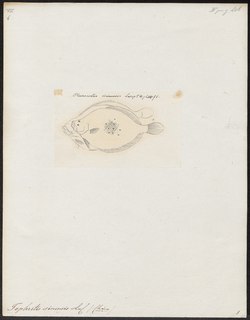 W
WTephrinectes sinensis, the Chinese brill, is a species of flatfish in the large-tooth flounder family, Paralichthyidae. It is the only member of its genus Tephrinectes. Like the rest of the large-tooth flounders, it has both eyes on the left side of its head.
 W
WTetronarce is a genus of rays, commonly known as electric rays. They are slow-moving bottom-dwellers capable of generating electricity as a defense and feeding mechanism. Tetronarce species tend to attain a much larger size than Torpedo species, which are usually small to moderate sized electric rays.
 W
WThe blacktip tope, also known as pencil shark or blacktip topeshark, is a houndshark of the family Triakidae, and the only member of the genus Hypogaleus. It is found in the deep waters of the continental shelf in the Indo-West Pacific, from East Africa to Japan, at depths between 40 and 230 m. It can grow up to a length of 1.27 m.
 W
WThe bay whiting is a species of coastal marine fish of the smelt-whiting family, Sillaginidae. The bay whiting's range extends throughout the west Indian Ocean, including northern Australia, Thailand, India and Taiwan, where it inhabits protected waters. It is benthic in nature, preying on shrimps, polychaetes and molluscs, however little else is known of its biology. Bay whiting are an important part of some inshore fisheries around Australia and Asia, where subsistence and commercial fishermen regularly take the species.